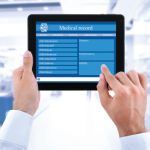For More Information
For more information or questions on the CMS Final Rule, contact Kayla Amodeo, and for all coding questions, training and/or billing guidelines, contact Antanya Chung or [email protected].
ad goes here:advert-1
ADVERTISEMENT
SCROLL TO CONTINUE
NEW PATIENT
| S: A 55-year-old female patient with pain in multiple joints is referred to the office by her primary care physician. She complains of pain in both knees and both shoulders. She rates the pain at 7 on the pain scale. Her pain is worse at night after she gets off work. Soaking in her hot tub for about 45 minutes seems to reduce the pain to a 5 on a 10-point scale. She has taken acetaminophen, which does not help. She states she was unsteady on her feet a few times the previous week. She denies any weight gain or loss, dyspnea, dysuria, rashes, hair loss, dysphagia, stomach or abdominal symptoms, chest pain or mood changes. She has no known allergies. She has no other medical problems.
PMHX: Total hysterectomy five years earlier for benign problems. ad goes here:advert-2 ADVERTISEMENT SCROLL TO CONTINUE SocHX: She does not smoke or consume alcohol. Fam HX: Mother had rheumatoid arthritis. She passed away last year in a car accident. Her father passed away 10 years ago and had no rheumatic diseases. She has no siblings or children. |
§ Chief complaint and history obtained and documented by ancillary staff or beneficiary.
§ Provider must review and sign off. |
| O: Her temperature is 98.7°F, height 5’6″, weight is 160 lbs. and blood pressure is 125/75 sitting. Patient is alert and oriented. She is well groomed. Her heart is regular and lungs are clear. Tendon reflexes are normal in the lower extremities. Her gait and stance are normal, and she has full range of motion with no inflammation or tenderness. A slight effusion in both knees is noted. Her muscle strength and tone are good. She has Heberden’s nodes. | § Vital signs performed and documented by ancillary staff
§ ROS—provider
§ Exam—provider |
| A: Pain in right and left elbow. Pain in right and left knee.
|
§ Provider |
| P: Celecoxib 100 mg BID. X-ray of shoulders and knees. Recommend ROM and quad-strengthening exercises. See PCP if unsteadiness persists.
|
§ Provider |
ESTABLISHED PATIENT
| S: A 39-year-old woman returns for follow-up for her rheumatoid arthritis. She has positive rheumatoid factor, but no organ or systemic involvement. She has joint swelling and pain in her left hand, right elbow and right knee. Her pain is at an 8 on a 10-point scale. She states the pain is worse in the evening after completing her workday as a school bus driver. She is currently on methotrexate 25 mg weekly. Her condition is worsening. She had bronchitis six weeks before and still has a dry cough, but no fever or dyspnea. The patient denies nausea, rashes, chest pain, headaches or palpitations. She has no known allergies. She had a miscarriage three years ago. She recently returned from visiting relatives in Russia. |


